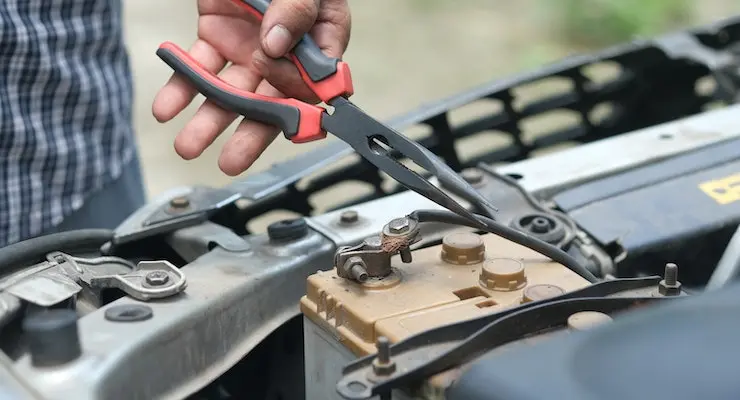The car battery is a critical component that allows engine ignition and powers all the electronics in a modern vehicle. But how exactly does the battery produce and store electricity to run your car’s various systems? The process involves converting chemical energy to electrical energy through electrochemical reactions.
The Role of the Car Battery
Before examining the energy conversion process, it helps to understand the vital roles a battery plays in powering your vehicle.
Engine Ignition
The car battery delivers the initial electrical jolt to start the starter motor and in turn ignite the engine’s combustion process. This kick-start electrical energy is essential.
Power Storage
In between engine running time, the battery stores reserve electric energy to maintain readings on gauges and preset radio stations along with other electronic memory banks.
Supplying Additional Electricity
The battery steps in to supply extra electricity when the charging system cannot meet all the vehicle’s electrical demands while idling or at low speeds.
Inside the Car Battery
The complex internal structure of the car battery allows it to reliably produce and store electricity through chemical reactions.
Lead-Acid Chemistry
Conventional car batteries use lead acid chemistry. This refers to a mix of lead plates and sulfuric acid inside the battery case.
Alternating Lead Plates
These lead plates alternate between a sponge-like porous lead material (positive plate) and a lead oxide material (negative plate). They are separated by insulators.
Sulfuric Acid Electrolyte
The lead plates are submerged in an electrolyte solution of about 30% sulfuric acid and 70% water which allows charge transfer.
The Chemical Reaction Process
The basic chemistry behind how a lead-acid car battery functions involves two important processes:
Discharging Electricity
When powering the car, the battery discharges stored electricity via a chemical reaction that produces lead sulfate and water from the sulfuric acid electrolyte.
Charging the Battery
While running, the car’s charging system reverses the reaction to replenish the sulfuric acid and remove lead sulfate deposits, allowing electricity to be stored once again.
Step-by-Step Energy Conversion
The way a car battery taps into chemical energy and converts it into usable electrical energy can be explained through a chain of events:
1. Chemical Reaction Creates Electron Flow
First, the chemical reaction between lead plates and sulfuric acid releases electrons which allows them to flow to the positive terminal.
2. Electrons Create Electric Current
This electron flow generates an electrical current which travels through the conductive battery materials and wiring.
3. Electric Current Powers the Load
When a power requirement like engine ignition occurs, this electric current flows through and powers the connected load.
4. Electricity Conversion Complete
Chemical energy has now successfully been converted to flow as electrical energy where it is needed. The process constantly repeats to meet electrical demands.
Maximizing the Conversion Process
Proper maintenance and operation of a car battery helps optimize the chemical to electrical energy conversion for performance.
Regular Charging
Fully recharging the battery after significant drain will maximize the sulfuric acid electrolyte for chemical reactions.
Preventing Sulfation Buildup
Allowing lead sulfate deposits to build up can inhibit chemical reactions and electricity generation. Prevention is key.
Monitoring Charge Level
Staying aware of your battery’s charge level and topping off when low provides the materials needed for current production.
Clean Terminals and Connections
Clean and corrosion-free terminals ensure the generated electrical current flows easily to your car’s systems.
Electrical Output and Measurement
The electrical energy generated by a car battery can be measured and characterized by two main units:
Voltage
This measures the difference in electric potential between two points, such as the positive and negative battery terminals. A car battery generates around 12 volts.
Amperage (Amps)
Amps measure the flow rate of the electrical current. Car batteries are rated by amp hours denoting current over time. Higher numbers indicate more power delivery.
Key Factors That Impact Conversion Efficiency
Many variables can affect how efficiently a car battery converts chemical energy to usable electricity:
Temperature
Cold temperatures impede the chemical reactions. Warm conditions within a battery’s operating range facilitate the reactions.
Age and Wear
As batteries age, chemical conversion becomes less efficient due to material degradation and sulfation buildup over time.
Discharge Rate
Drawing current from the battery too quickly can overburden the conversion reactions and lead to voltage drops. Steady discharge is best.
Maintenance and Condition
Proper maintenance like routine cleaning helps batteries function at peak conversion efficiency throughout their lifespan.
Conclusion
Whether turning over a cold engine or powering lighting, every function of a modern car depends on the electricity generated by its battery. This electricity originates from the chemical reactions between lead and sulfuric acid within the battery itself. Through a complex process of controlled exchanges and electron transfers, the chemical energy stored in the battery is harnessed and converted to provide the essential electrical energy that powers your vehicle. With proper maintenance and operating conditions, car batteries can reliably optimize this conversion for dependable performance mile after mile.
